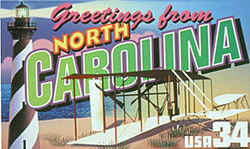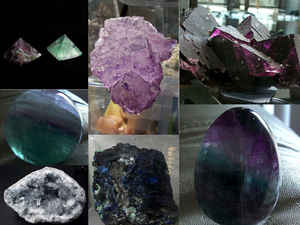
North Carolina Symbols
North Carolina State Mineral
Gold
(Aurum)
Adopted on February 4, 2011
At least two other states have designated gold as their state mineral - Alaska and
California.
The discovery of gold by a twelve year old boy in 1799 in Cabarrus County started North Carolina's gold rush. The boy's name was Conrad Reed, and the
location developed into the Reed Gold Mine.
The bill was initially introduced by Senate Majority Leader Harry Brown of Onslow County on behalf of a fourth grade class at Clyde Erwin Magnet Elementary
School.
Senator Harry Brown, of Jacksonville, filed Senate Bill No. 129(SB129), designating gold North Carolina's official state mineral, on February 4, 2011. His bill included the Latin name for gold, Aurum, in the text.
North Carolina was once a major gold producing state. In 1788, a 17-pound nugget was discovered in Cabarras County. That discovery touched off the first true gold rush in the United States. During the mid-1800's gold coins were minted at the privately owned Bechtler Mint in Rutherford County and a branch of the United States Mint in Charlotte. Although large-scale gold production ended in the 1800's; gold production continued until 1942. New mining technology has renewed interest in commercial gold production.
North Carolina State Mineral: Gold

Ores of chromium, copper, gold and silver, iron, lead and zinc, manganese, molybdenum, nickel, tin, titanium, and tungsten all occur in either the Piedmont or Mountain Provinces. Although of little importance in the state's mining industry today, gold, copper, iron, and tungsten were produced in the past.
North Carolina was the nation's leading gold producer prior to the 1849 discoveries in California. Because of its geologic similarity to important metal mining districts in Canada, the Carolina Slate Belt has been an area of extensive exploration.
Carolina Slate Belt - This belt consists of heated and deformed volcanic and sedimentary rocks. It was the site of a series of oceanic volcanic islands abou 550-650 million years ago. The belt is known for its numerous abandoned gold mines and prospects. North Carolina led the nation in gold production before the California Gold Rush of 1849. In recent decades, only monor gold mining has taken place, but mining companies continue to show interest in the area.
Eastern Slate Belt - This belt contains slightly metamorphosed volcanic and sedimentary rocks similar to those of the Carolina slate belt. The rocks are poorly exposed and partially covered by the Coastal Plain sediments.The metamorphic rocks, 500-600 million years old, are intruded by younger, approximately 300 million-year-old, granitic bodies. Gold was once mined in the belt, and small occurrances of molybdenite, and ore of molybdenum, have been prospected here.
Physical Characteristics of Gold:

Gold is a chemical element with the symbol Au and atomic number 79. It is a dense, soft, malleable and ductile metal with a bright yellow color and luster, the properties of which remain without tarnishing when exposed to air or water. Chemically, gold is a transition metal and a group 11 element. It is one of the least reactive chemical elements, and is solid under standard conditions. The metal therefore occurs often in free elemental (native) form, as nuggets or grains, in rocks, in veins and in alluvial deposits. Less commonly, it occurs in minerals as gold compounds, such as with tellurium as calaverite, sylvanite, or krennerite.
- Name gold
- Symbol Au
- Atomic number 79
- Atomic weight 196.966569
- Color is golden "butter" yellow.
- Luster is metallic.
- Transparency is opaque.
- Crystal System is isometric; 4/m bar 3 2/m
- Crystal Habits include massive nuggets and disseminated grains. Also wires, dendritic and arborescent crystal clusters.
- Cleavage is absent.
- Fracture is jagged.
- Streak is golden yellow.
- Hardness is 2.5 - 3
- Specific Gravity is 19.3+ (extremely heavy even for metallic minerals)
- Associated Minerals include quartz, nagyagite, calaverite, sylvanite, krennerite, pyrite and other sulfides.
- Other Characteristics: ductile, malleable and sectile, meaning it can be pounded into other shapes, stretched into a wire and cut into slices.
- Notable Occurrences include California and South Dakota, USA; Siberia, Russia; South Africa; Canada and other localities around the world.
- Best Field Indicators are color, density, hardness, sectility, malleability and ductility.
North Carolina Senate DRS35073-MA-140 (02/16)
GENERAL ASSEMBLY OF NORTH CAROLINA
SESSION 2011
SD
SENATE DRS35073-MA-140 (02/16)
Short Title: State Mineral Is Gold. (Public)
Sponsors: Senator Brown.
Referred to:
A BILL TO BE ENTITLED
AN ACT TO MAKE GOLD (AURUM) THE STATE MINERAL.
The General Assembly of North Carolina enacts:
SECTION 1. Chapter 145 of the General Statutes is amended by adding a new section to read:
"§ 145-34. State mineral.
Gold (Aurum) is adopted as the official State mineral of the State of North Carolina."
SECTION 2. This act is effective when it becomes law.
SB129 passed into law when Governor Bev Purdue signed the bill on June 23, 2011.
Minerals, & Gems

Gemstone, Minerals, Rocks






